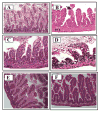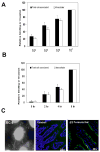Enterobacter sakazakii enhances epithelial cell injury by inducing apoptosis in a rat model of necrotizing enterocolitis
- PMID: 18588483
- PMCID: PMC2497445
- DOI: 10.1086/590186
Enterobacter sakazakii enhances epithelial cell injury by inducing apoptosis in a rat model of necrotizing enterocolitis
Abstract
Necrotizing enterocolitis (NEC) is an inflammatory intestinal disorder that affects 2%-5% of all premature infants. Enterobacter sakazakii, a common contaminant of milk-based powdered infant formula, has been implicated as a causative agent of sepsis, meningitis, and NEC in newborn infants, with high mortality rates. However, the role played by E. sakazakii in the pathogenesis of NEC is, to date, not known. Here, we demonstrate for the first time that E. sakazakii can induce clinical and histological NEC in newborn rats. E. sakazakii was found to bind to enterocytes in rat pups at the tips of villi and to intestinal epithelial cells (IEC-6) in culture, with no significant invasion. Exposure to E. sakazakii induced apoptosis and increased the production of interleukin-6 in IEC-6 cells and in the animal model. These data suggest that E. sakazakii could be a potential pathogen that induces NEC and triggers intestinal disease by modulating enterocyte intracellular signaling pathways.
Conflict of interest statement
The authors do not have a commercial or other association that might pose a conflict of interest.
Figures







References
-
- Mullane NR, Iversen C, Healy B, et al. Enterobacter sakazakii an emerging bacterial pathogen with implications for infant health. Minerva Pediatr. 2007;59:137–48. - PubMed
-
- Simmons BP, Gelfand MS, Haas M, Metts L, Ferguson J. Enterobacter sakazakii infections in neonates associated with intrinsic contamination of a powdered infant formula. Infect Control Hosp Epidemiol. 1989;10:398–401. - PubMed
-
- Kandhai MC, Reij MW, Gorris LG, Guillaume-Gentil O, van Schothorst M. Occurrence of Enterobacter sakazakii in food production environments and households. Lancet. 2004;363:39–40. - PubMed
-
- Peter CS, Feuerhahn M, Bohnhorst B, et al. Necrotising enterocolitis: is there a relationship to specific pathogens? Eur J Pediatr. 1999;158:67–70. - PubMed

